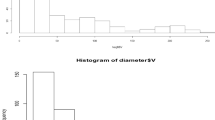Abstract
Partially rank-ordered set sampling (PROSS) is a generalization of ranked-set sampling (RSS) in which the ranker is not required to give a full ranking in each set. In this paper, we study the efficiency of the PROSS sample mean under perfect rankings for various PROSS schemes. We obtain conditions under which one PROSS scheme is always more efficient than another, and we also obtain conditions under which how the efficiencies of two PROSS schemes compare depends on the particular distribution. We completely determine how PROSS schemes compare in the two-subset case, and we also prove a conjecture of Ozturk (Environ Ecol Stat 18:757–779, 2011) about how the efficiency of the PROSS sample mean compares to that of the RSS sample mean.
Similar content being viewed by others
References
Abu-Dayyeh W, Assrhani A, Ibrahim K (2013) Estimation of the shape and scale parameters of Pareto distribution using ranked set sampling. Stat Pap 54:207–225
Abu-Dayyeh W, Al Sawi E (2009) Modified inference about the mean of the exponential distribution using moving extreme ranked set sampling. Stat Pap 50:249–259
Arnold BC (2007) Majorization: here, there and everywhere. Stat Sci 22:407–413
David HA, Nagaraja HN (2003) Order statistics, 3rd edn. Wiley, New York
Feeman TG, Frey J (2016) Efficiency bounds for a generalization of ranked-set sampling, to appear in Commun Stat Theory Methods
Frey J (2007) Distribution-free statistical intervals via ranked-set sampling. Can J Stat 35:585–596
Gao J, Ozturk O (2012) Two sample distribution-free inference based on partially rank-ordered set samples. Stat Probab Lett 82:876–884
Halls LK, Dell TR (1966) Trial of ranked-set sampling for forage yields. For Sci 12:22–26
Harter HL (1961) Expected values of normal order statistics. Biometrika 48:151–165
Howard RW, Jones SC, Mauldin JK, Beal RH (1982) Abundance, distribution, and colony size estimates for Reticulitermes spp. (Isopter: Rhinotermitidae) in Southern Mississippi. Environ Entomol 11:1290–1293
Hussein A, Muttlak HA, Al-Sawi E (2013) Group sequential methods based on ranked set samples. Stat Pap 54:547–562
Jafari Jozani M, Majidi S, Perron F (2012) Unbiased and almost unbiased ratio estimators of the population mean in ranked set sampling. Stat Pap 53:719–737
Kadilar C, Unyacizi Y, Cingi H (2009) Ratio estimation for the population mean using ranked set sampling. Stat Pap 50:301–309
Kvam PH (2003) Ranked set sampling based on binary water quality data with covariates. J Agric Biol Environ Stat 8:271–279
Li W, Liu T, Bai Z (2012) Rounded data analysis based on ranked set sample. Stat Pap 53:439–455
MacEachern SN, Ozturk O, Wolfe DA, Stasny EA (2002) A new ranked set sample estimator of variance. J R Stat Soc Ser B 64:177–188
Marshall AW, Olkin I, Arnold BC (2011) Inequalities: theory of majorization and its applications, 2nd edn. Springer, New York
McIntyre GA (1952) A method for unbiased selective sampling, using ranked sets. Aust J Agric Res 3:385–390
McIntyre, G. A. (2005). A method for unbiased selective sampling, using ranked sets Am Stat 59:230–232 (Originally appeared in Aust J Agric Res 3:385–390)
Ozturk O (2011) Sampling from partially rank-ordered sets. Environ Ecol Stat 18:757–779
Ozturk O (2012) Quantile inference based on partially rank-ordered set samples. J Stat Plan Inference 142:2116–2127
Sillitto GP (1964) Some relations between expectations of order statistics in samples of different sizes. Biometrika 51:259–262
Stokes SL (1995) Parametric ranked set sampling. Ann Inst Stat Math 47:465–482
Stokes SL, Sager TW (1988) Characterization of a ranked-set sample with application to estimating distribution functions. J Am Stat Assoc 83:374–381
Takahasi K, Wakimoto K (1968) On unbiased estimates of the population mean based on the sample stratified by means of ordering. Ann Inst Stat Math 20:1–31
Acknowledgments
The authors thank the reviewers for suggestions that have improved the paper.
Author information
Authors and Affiliations
Corresponding author
Rights and permissions
About this article
Cite this article
Frey, J., Feeman, T.G. Efficiency comparisons for partially rank-ordered set sampling. Stat Papers 58, 1149–1163 (2017). https://doi.org/10.1007/s00362-016-0742-2
Received:
Revised:
Published:
Issue Date:
DOI: https://doi.org/10.1007/s00362-016-0742-2



